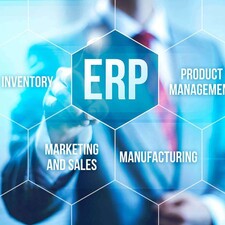Blog
How Advanced Planning and ERP Scheduling (APS) Transforms your Manufacturing Environment

Summary
Utilizing an Advanced Planning and ERP Scheduling, or APS, system will transform your manufacturing environment and make your wildest manufacturing dreams come true, and it all integrates with your ERP system. Imagine a manufacturing environment where you meet more customer delivery dates, reduce the number of manufacturing changeovers/setups needed, where your manufacturing floor has complete visibility of upcoming fixed and expected work orders, and where your executive management can see key metrics about vendor performance, expected machine utilization, and worker performance.
Meet more of your customers delivery dates
1. Real-Time Promise Dates from Finite ERP Scheduling and Order Prioritization
We’ve all had it happen to us at different points in our working lives. You’re working on something, and someone messages you asking you to work on something else. You're on a call, and someone calls in asking you to fit something into your current schedule for the day because they need you to read that memo NOW!
Sometimes, it seems like there aren’t enough hours in the day, and it can be difficult to tell your customers, managers, or employees when you expect to complete something, especially if you’re limiting yourself to an 8-10 hour business day or want to have work-life balance like software dude Peter Gibbons in that movie “Office Space.” Will I be able to complete this additional task and when? To provide an accurate answer in these situations, you have to lay out each action item back to back with expected downtime.
Learn how the Industrial Internet of Things will impact your business. Download the guide: How to Leverage IIoT with Modern ERP
This same concept applies to manufacturing planning. Every customer wants their order when they ask for it. Offering a customer a realistic promise date from the start of the sales process can save a lot of heartache later and ensure that you continue building goodwill with both new customers and long-time customers. Advanced Planning and ERP Scheduling systems run simulations that provide real-time expected completion dates based off of current workload, system-populated item master data (e.g., run times, setup times, batch sizes, and routing preferences) and capacity data (e.g., number of shifts, number of hours per shift, work center schedule, work center throughput, work center staff allocation, worker performance).
Increasing batch sizes while meeting delivery date parameters
2. Setup Time Optimization
When operating in a high-velocity manufacturing environment, every second counts. A big goal of any manufacturing environment is to reduce your setup times. From a traditional manufacturing or engineering viewpoint, this is accomplished by finding ways to physically reduce the time it takes for each setup. In layman's terms, the traditional thought process is that if you move faster, you reduce total time spent reaching your desired destination.
From an optimization standpoint, total setup time reduction can also be minimized if multiple work orders that share the same setup are sequenced together accordingly. This means that you can still run the same speed for each setup, you just need to get your ducks in a row! An enterprise-level Advanced Planning and ERP Scheduling system provides sequenced work orders within the parameters you set for allowable batch grouping period and on-time performance.
Creating visibility of confirmed production orders and expected production orders for manufacturing
3. Visibility of upcoming fixed and expected work orders
With your advanced planning and ERP scheduling module, a detailed plan is created that provides visibility of upcoming fixed and expected work orders. This means that your manufacturing team knows which orders are coming to their work center before they arrive and can plan for the expected product mixes that are headed down the pipeline.
Most people like to be able to see what’s on their plate. When working with backwards scheduling and infinite capacity, your upcoming schedule is only accurate if you are completely on-time and starting work when it should be started. The reality is that schedules and priorities change. Being able to see these changes as they occur means you always know what product mix is on the floor no matter where you are. Information matters. If you’re trying to cut back on sugar, you can simply read the nutritional label on the food you buy and hence make better (lower sugar) choices when you shop. That same approach to visibility of data helps drive efficiency in manufacturing, and ERP scheduling delivers that visibility to support better decisions.
Visible vendor, work order, and employee KPIs that inform executive business decision making
4. Visible KPIs that Help Business Executives Make Strategic Decisions
Being able to see vendor, work order and employee KPI's helps executives make informed business decisions. Advanced Planning and Scheduling makes it possible to see statuses of upcoming vendor shipments, evaluate employee utilization by work center, and determine work order on-time completion rates for the entire facility. Having this data available at your fingertips makes it possible for executives to be executives. As a result of this data, executives can:
- Determine which vendors are meeting their desired metrics levels and renegotiate terms based on performance
- Quickly decide which work centers are lagging behind and prescribe corrective action (e.g. training, reassigned resources, additional resources, changed process, depending on what is needed to improve conditions)
- Determine the overall performance of a manufacturing facility and compare to other like facilities in their portfolio and compare to industry-specific benchmarks.
Whether it's being able to tell that irritating “Office Space” boss Bill Lumbergh what your promise date is (so he doesn’t keep visiting your cubicle demanding updates), going smarter not faster through setup time optimization, making things visible with your detailed plan, or finally knowing what's going on with your vendors/work centers/manufacturing facility portfolio, a properly configured enterprise-level APS module will help you realize your manufacturing fantasy.
Considering a new ERP system? Download the Guide: How to Buy ERP Software in 7 Easy Steps


